Unicraft 1/72 Boeing X-45A UCAV | | History Not much yet but here is the write up from the Boeing website To a large audience of customers, suppliers and employees, Boeing provided a preview in St. Louis today of a revolutionary new weapon system concept called the Unmanned Combat Air Vehicle (UCAV). 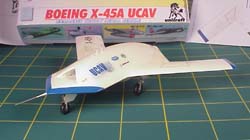 The UCAV advanced technology demonstration system is being developed by the Boeing Phantom Works R&D division under a $131 million, 42-month cost-share agreement with the Defense Advanced Research Projects Agency (DARPA) and the U.S. Air Force. The UCAV advanced technology demonstration system is being developed by the Boeing Phantom Works R&D division under a $131 million, 42-month cost-share agreement with the Defense Advanced Research Projects Agency (DARPA) and the U.S. Air Force. Awarded to Boeing in March 1999, the program is designed to prove the technological feasibility of multiple UCAVs autonomously performing extremely dangerous and high-priority combat missions to augment the manned fighter strike force. The first such mission envisioned is the suppression of enemy air defenses. "The development and deployment of UCAVs could significantly increase the effectiveness and survivability of manned fighter aircraft while lowering the overall cost of combat operations," said George Muellner, vice president-general manager of the Boeing Phantom Works and host of the event. "Boeing is excited to be opening new frontiers with the development of this revolutionary new concept." Because of their small size, lack of pilot interfaces and training requirements, reusability and long-term storage capability, UCAVs are projected to cost up to 65 percent less to produce than future manned fighter aircraft and up to 75 percent less to operate and maintain than current systems. 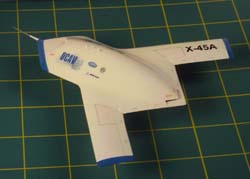 To perform a mission, multiple UCAVs will be equipped with preprogrammed objectives and preliminary targeting information by ground-based mission planners. This mission can then be carried out autonomously, but can also be managed interactively or revised en route by UCAV controllers should new objectives or targeting information dictate. Upon return, the air vehicle can be immediately prepared for another mission, or it can be dismantled and placed into a container for shipment elsewhere or storage up to 10 years. Container interfaces allow for periodic maintenance monitoring and software updating of the vehicle inside, which can be reassembled and prepared for combat within an hour. To perform a mission, multiple UCAVs will be equipped with preprogrammed objectives and preliminary targeting information by ground-based mission planners. This mission can then be carried out autonomously, but can also be managed interactively or revised en route by UCAV controllers should new objectives or targeting information dictate. Upon return, the air vehicle can be immediately prepared for another mission, or it can be dismantled and placed into a container for shipment elsewhere or storage up to 10 years. Container interfaces allow for periodic maintenance monitoring and software updating of the vehicle inside, which can be reassembled and prepared for combat within an hour. Believe it or not, Grumman has also developed a UCAV, which very much resembles a delta diamond shape. I'd be interested to ask Igor if this vehicle is next on his list? The kit: Yehaaaaa! 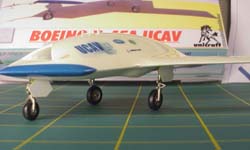 Not only was I fortunate to get this kit before you did, but I can be happy to tell you it was fun to build! The kit is U-NEE-QUE to say the least. It consists of only four major parts needed to build the whole fuselage, minus the needed parts for the gear and doors. There is no cockpit, just an air intake with a tunnel and an engine front at the end of the tunnel. The quality of molding is very good, careful cutting from the pour blocks is about the hardest part of assembly. I used a bit more putty than usual due to some over zealous sanding of the nosepieces. Not only was I fortunate to get this kit before you did, but I can be happy to tell you it was fun to build! The kit is U-NEE-QUE to say the least. It consists of only four major parts needed to build the whole fuselage, minus the needed parts for the gear and doors. There is no cockpit, just an air intake with a tunnel and an engine front at the end of the tunnel. The quality of molding is very good, careful cutting from the pour blocks is about the hardest part of assembly. I used a bit more putty than usual due to some over zealous sanding of the nosepieces. The usual instructions with a good assembly breakdown was tucked in the small box, barely big enough for the kit parts. The instructions and the artwork are getting better with each new offering. However, the landing gear illustration is incorrect, the main gear wheels should be facing inward and not outwards as on the instruction sheet. The resin seems a bit less brittle than in earlier kits, and I noticed a slightly different odor when sanding and cutting it. Decals are made on an Alps printer so be a bit more careful when handling them. After the main parts have been finished, clean up of the landing gear is quick. Also a first for Igor at Unicraft are wire inserts in the landing gear legs! No more sagging gear legs, Bravo Igor! 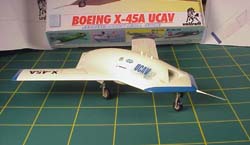 The four main pieces go on just fine, all that was added was a bit of bondo to the top of the craft to sort of smooth and contour, it seemed to have a bit of a step. Most of my time was eliminating a lot of very tiny pin holes that collected around the leading edge of the wings, I'm certain I did not get them all yet. The four main pieces go on just fine, all that was added was a bit of bondo to the top of the craft to sort of smooth and contour, it seemed to have a bit of a step. Most of my time was eliminating a lot of very tiny pin holes that collected around the leading edge of the wings, I'm certain I did not get them all yet.
The landing gear are simplified versions of the real thing, all they lack are the oleo scissors and a retraction strut, gear doors are commendably thin but stubborn to remove from the pour blocks. I ended up scratch-building the doors as the originals broke, with a little help from my overly anxious fingers. What paint scheme to do – Hmmmmmm. Two choices are on the decal sheet, a fictitious USAF aircraft, and the Rollout model. I chose to do the Prototype rollout version, all white with some blue trim. The white is Floquil Reefer white with the blue being Testors Blue, in the small bottle. For the first time Future wax wasn't used before the decals were laid down. Instead I read about using Testor Metalizer sealer. It works very well, dries much faster, (for those speed demons out there) and does not turn yellow after repeated applications – and when using white paint, yellowing is a no-no. Despite being careful, some specks of dust were bound to collect on the white. Small surface imperfections are easily wet sanded out as this sealer dries quickly. 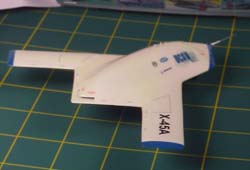 Looks hot! Since I'm doing the rollout model, some scratch building of the nose probe with its cluster of instruments is next. Being in 1/72 scale you need not get really detailed. Also don't forget a small air intake directly under the engine, looks like a breather inlet of sorts. Decals are applied and as they are going over white, care must be taken not to soil the finish, white shows dirt so easily. I do hope the containers these babies are kept in can keep the dust off of them. One decal which was noticeably missing are some black panel outlines for the top of the wings, they are quite evident in the Boeing photographs so out came the Alps printer and some were fashioned. Looks hot! Since I'm doing the rollout model, some scratch building of the nose probe with its cluster of instruments is next. Being in 1/72 scale you need not get really detailed. Also don't forget a small air intake directly under the engine, looks like a breather inlet of sorts. Decals are applied and as they are going over white, care must be taken not to soil the finish, white shows dirt so easily. I do hope the containers these babies are kept in can keep the dust off of them. One decal which was noticeably missing are some black panel outlines for the top of the wings, they are quite evident in the Boeing photographs so out came the Alps printer and some were fashioned. Conclusion All in all a nice little craft! And it looks so much like the stealth designs we have come to expect. I give this kit 8 out of 10 for design and engineering, 8 for coolness, and a 6 for difficulty. Another great model from the Ukraine, so sign up now, they're limited! | 

 




|